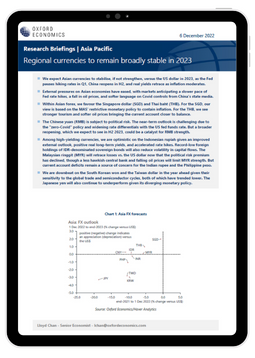Research Briefing
| Dec 6, 2022
Asian currencies to remain broadly stable in 2023

We expect Asian currencies to stabilise, if not strengthen, versus the US dollar in 2023, as the Fed pauses hiking rates in Q1, China reopens in H2, and real yields retrace as inflation moderates.
What you will learn:
- External pressures on Asian economies have eased, with markets anticipating a slower pace of Fed rate hikes, a fall in oil prices, and softer language on Covid controls from China’s state media.
- Within Asian forex, we favour the Singapore dollar (SGD) and Thai baht (THB). For the SGD, our view is based on the MAS’ restrictive monetary policy to contain inflation. For the THB, we see stronger tourism and softer oil prices bringing the current account closer to balance.
- The Chinese yuan (RMB) is subject to political risk. The near-term outlook is challenging due to the “zero-Covid” policy and widening rate differentials with the US fed funds rate. But a broader reopening, which we expect to see in H2 2023, could be a catalyst for RMB strength.
Tags:
Related Services

Service
Asian Cities and Regional Forecasts
Key economic, demographic, and income and spending projections to 2035 for more than 400 locations across Asia-Pacific.
Find Out More
Service
FX Risk Tool
A rigorous and transparent framework to measure the risk of a sharp currency depreciation.
Find Out More
Service
Global Risk Service
A suite of data-driven and forward-looking tools that provide an objective and transparent measure of risk.
Find Out More